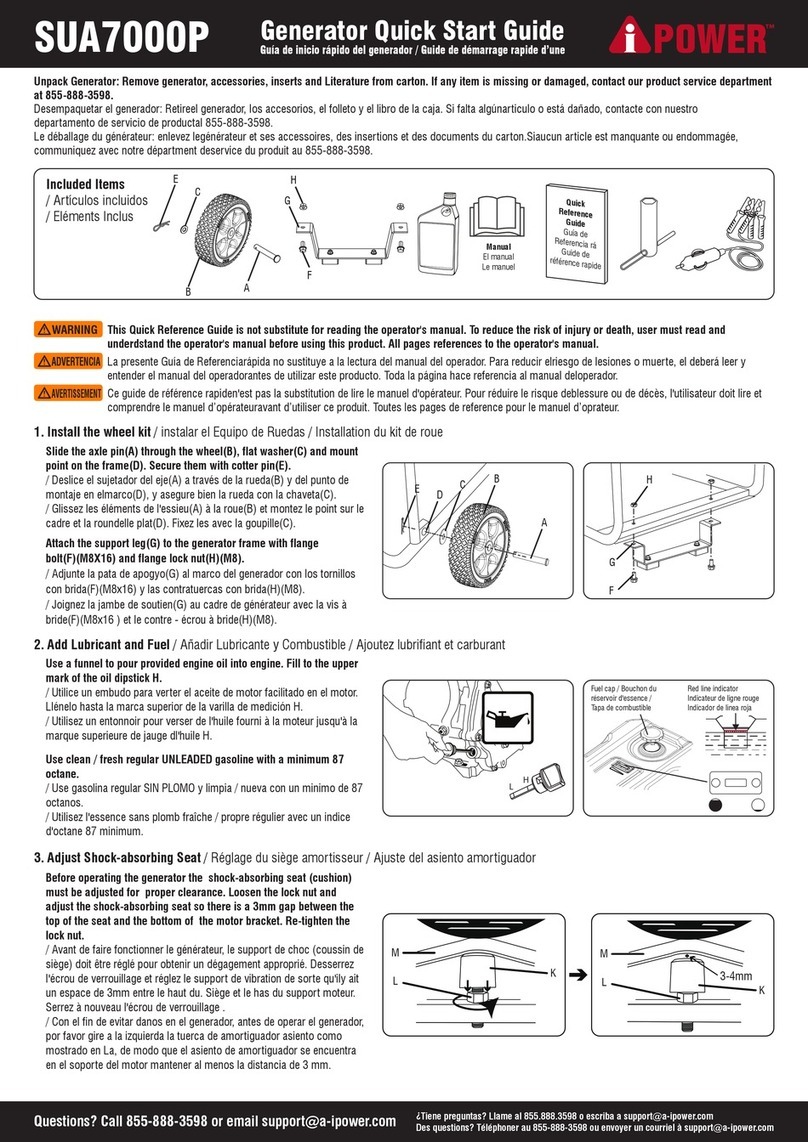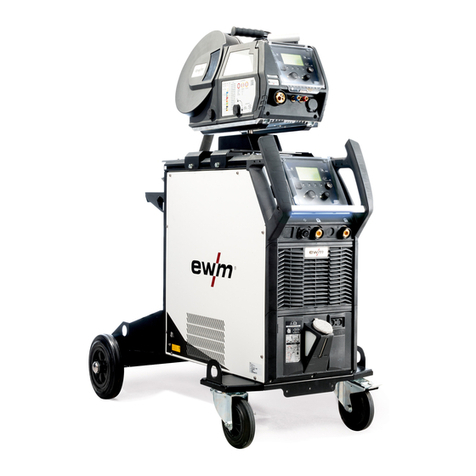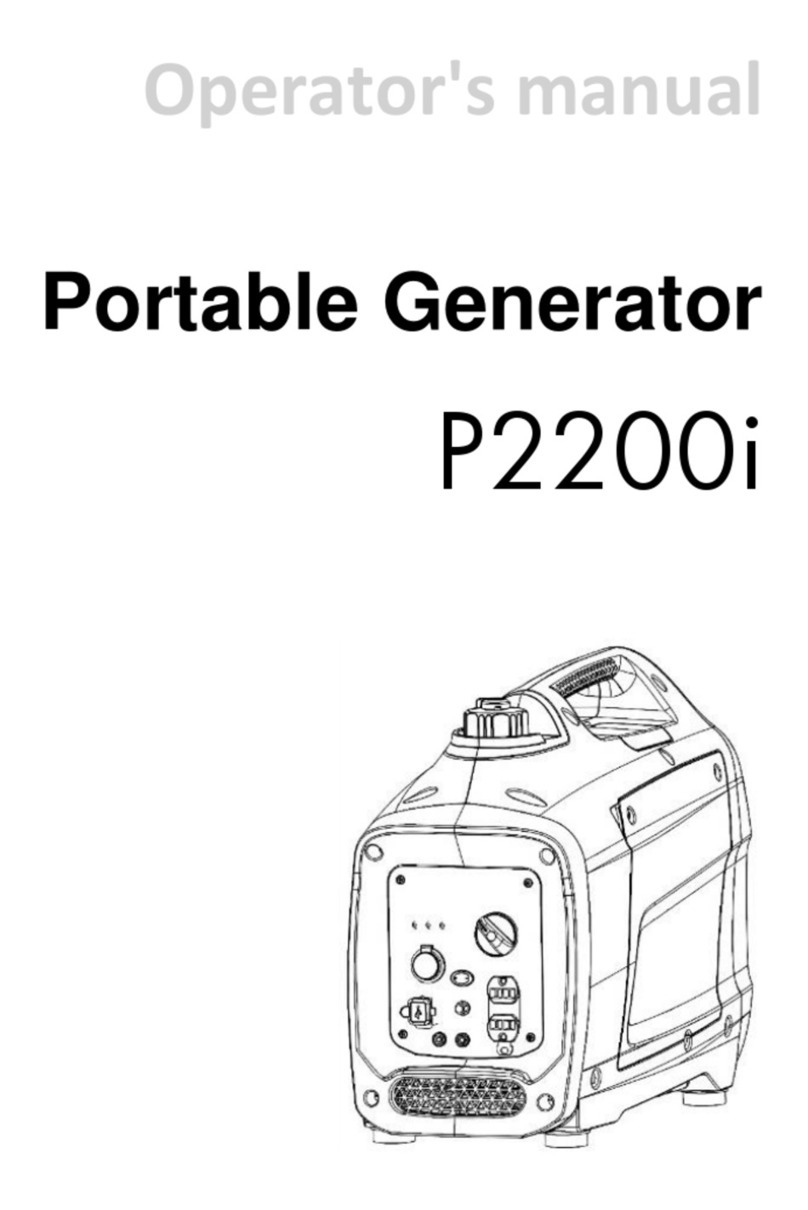ellman Surgitron 4.0 Dual RF/120 IEC User manual

074-01-03

1
CONTENTS
I. INTRODUCTION Page 2
1.0 Introduction to Radiosurgery
1.1 Symbol Definitions
1.2 Packing List
II. TECHNICAL INFORMATION Page 3
2.0 Distributor and Manufacturer Information
2.1 General Description
2.2 Applicable Specifications
2.3 RF Power Output
2.4 Modulation (Waveforms)
2.5 Timing
2.6 Classification
2.7 Preventive Inspection and Maintenance
III. CAUTION AND WARNING Page 6
3.0 Caution and Warning
3.1 Safety Instructions
IV. DESCRIPTION OF CONTROL ELEMENTS Page 7
4.0 Special Feature:
Mode and Power Output Level Memory
Dual Footswitch and Three-Button Fingerswitch Handpiece
4.1 Rear Panel
4.2 Front Panel
V. PREPARATION FOR USE Page 14
5.0 Preparation for Use
5.1 Operational Preparation and Functional Selection
of the Surgitron Dual Frequency
VI. CLINICAL INFORMATION AND PRACTICING PROCEDURES Page 15
6.1 Learning to Use Radiosurgery
6.2 Waveform
6.3 Pre-Operative Cutting Practice
6.4 Anesthesia
VII. TECHNICAL SPECIFICATIONS Page 18
7.1 Output Character
7.2 Safety Features
7.3 Input Character
7.4 Size and Weight
7.5 Error Codes Table
VIII. FIGURES Page 20
8.1 Power Output vs. Digital Setting (500 Ohms Resistive Load)
8.2 Cut Mode Power Output vs. Resistive Load
8.3 Coag Mode Power Output vs. Resistive Load
8.4 Hemo Mode Power Output vs. Resistive Load
8.5 Fulgurate Mode Power Output vs. Resistive Load
8.6 Bipolar Mode Power Output vs. Resistive Load
Rev. d
4/02

2
I. INTRODUCTION
1.0 INTRODUCTION TO RADIOSURGERY
Surgery that is performed with modern radiosurgical equipment should not be confused with the results obtained
with electrocautery, medical diathermy, spark gap generators, or partially rectified devices that do not provide
surgical cutting waveforms. Thus, before reviewing the instructions and clinical use, a brief definition of
radiosurgery and of the radiofrequency waves that produce this phenomenon may prove helpful.
Radiosurgery is an atraumatic method of cutting and coagulating soft tissue, without the post-op pain and tissue
destruction of electrocautery. The cutting effect, known as electrosection, is performed without manual pressure
or crushing tissue cells. It results from heat generated by the resistance the tissues offer to the passage of a
radiofrequency wave, which is applied with a fine wire called a surgical electrode. The heat disintegrates and
volatizes the cells in the path of the waves. This causes the tissue to split apart as though it had been cut with a
razor-sharp knife. Electrocoagulation is a nonvolatilizing destruction of tissue cells by a radiofrequency wave.
The atraumatic nature of electrosection provides a noteworthy advantage. The lack of trauma results in tissue
healing without fibrous contractile scar tissue, which characterizes healing of wounds created by manual cutting.
Radiosurgery, as a result of these advantages, facilitates, accelerates, and improves surgical procedures
tremendously. It also helps to eliminate the unfavorable post-operative sequelae such as swelling, infection, and
postsurgical shock from excessive blood loss, that are so often experienced after “traditional” instrumentation for
comparable surgery.
1.1 SYMBOL DEFINITIONS
1.1.1 Classification = Class 1
1.1.2 Supply input power = 240V, 220V120V,100V~ 50/60 Hz.
1.1.3 Type BF defibrillator protection
1.1.4 Refer to manual
1.1.5 Protective earth connection
1.1.6 Neutral electrode referenced to ground
1.1.7 Fingerswitch control
1.1.8 Footswitch control
1.1.9 Neutral plate
1.1.10 Non-Ionization radiation
WARNING
Richard Wolf and ellman international strongly
recommend the use of the ellman Corneal Eye
Shield for any radiofrequency surgical procedure
involving the eyelid and the immediate
surrounding areas.

3
1.2 PACKING LIST Wolf Part Number
1.2.1 Wolf / ellman Surgitron 4.0 Dual RF/120 IEC 2343.001
1.2.2 IEC Power cord 2343.903
1.2.3 Dual Footswitch & Cable 2343.901
1.2.4 IEC Foot Controlled Handpiece, 1/16" shaft 8792.698
1.2.5 Bipolar Cable 2343.837
1.2.6 Disposable Neutral Plate 2343.011
1.2.7 Instruction Manual -
1.2.8 Three-Button Fingerswitch Handpiece 8792.696
OPTIONAL PARTS
1.2.9 Fingerswitch Handpiece 3/32" Shaft
1.2.10 Electrode Set 1/16" Shaft
1.2.11Bipolar Forceps
1.2.12 Disposable Three-Button Fingerswitch Handpieces
1.2.13 Neutral Plate
1.2.14 Surgi-Cart III
1.2.15 Vapor-Vac II
II. TECHNICAL INFORMATION
2.0 DISTRIBUTOR’S INFORMATION MANUFACTURER’SINFORMATION
Richard Wolf Medical Instruments Corporation ellman international inc.
353 Corporate Woods Parkway 1135 Railroad Avenue
Vernon Hills, Illinois 60061-3110 Hewlett, New York 11557
(800) 323-WOLF (9653) (516) 569-1482
sales&[email protected]
Manufacturer will make available on request circuit diagrams, component parts list, description, calibration
instructions or other information necessary to assist the user's appropriately qualified technical personnel.
Technical specifications subject to change without notice.
2.1 GENERAL DESCRIPTION
The Wolf / ellman Surgitron 4.0 Dual RF/120 IEC enhanced capability Radiosurgical Generator
described herein is a compact source of high frequency low temperature RF energy to be employed for a
variety of radiosurgery procedures. This action is achieved by front panel selection of waveforms and
power levels. All selections are effected through push buttons and lamps which give the operator feedback
of status. Power level for each mode is indicated by front panel digital displays which also show the status
of self-test and monitoring. This display is interlocked with the controls to prevent operation when FAIL is
displayed. The final output power control is made through foot and/or hand switches. An internal memory
provides a special feature for the storage of all the front settings, mode and power output levels. Both
Monopolar and Bipolar electrodes are available. This unit is designed to comply with international safety
standards.
2.2 APPLICABLE SPECIFICATIONS
The following specifications are applicable to the extent called out herein.
IEC 60601-1 Medical Electrical Equipment - Part 1 General Requirements for Safety
IEC 60601-2-2 Medical Electrical Equipment - Part 2 Particular Requirements for Safety
UL 2601 Medical Electrical Equipment Safety (USA Version)
CSA 22.2601 Medical Equipment Safety (Canadian Version)

4
2.3 RF POWER OUTPUT
2.3.1 Output Level
The power output in the CW (CUT) mode is 120 watts into (500 ohm) a matched load.
2.3.2 Output Level Stability
The output is adjustable from less than 5W to maximum with little change in slope.
2.3.3 Power Output Stability
Impedance range of 50 ohms - 2K at any power setting or waveform setting.
2.3.4 Power Output Level Stability
Once enabled, the output remains constant within +/-10% turn on for a period of 10 seconds.
2.3.5 Power Output Purity
In the CW CUT mode harmonics and spurious are at least 20dB below the reference output for
any load impedance in the range of 50 ohms to 2K ohms.
2.3.6 Frequency Accuracy
The output frequency is maintained at 4.0 MHz +/- 400Hz over all service and loading conditions
including short and open for monopolar mode.
2.4 MODULATION (WAVEFORMS)
FOUR OUTPUT WAVEFORMS ARE PROVIDED.
2.4.1 CW CUT
Continuous wave output with average power equal to the maximum with no deliberate modulation.
2.4.2 CUT/COAG
Deeply modulated envelope with average to peak power ratio approximately 50%. Modulation
occurring at 120 or 100 Hz rate.
2.4.3 HEMO
Deeply modulated square wave with average to peak ratio approximately 35% Modulation
occurring at a 60 or 50 Hz rate.
2.4.4 FULGURATE
Deeply modulated wave with average to peak ratio to 10% or less. Modulation occurring at random
rate but no greater than 1 KHz.
2.5 TIMING
The suggested operational duty cycle is 10 sec. ON/ 30 sec. OFF. The yellow indicator will be ON when
CUTTING MODE circuit is energized. And the blue indicator will be ON when COAGULATION MODE
circuit is energized. The unit will “beep” continuously when ON with a tone after 55 seconds of applied
power at any level and in any mode. It shall change after 55 seconds and turn off after another 5 seconds.
2.6 CLASSIFICATION
2.6.1 According to the type of protection against electrical shock: the equipment is energized from an
external electrical power source and is Class I equipment.
2.6.2 According to the degree of protection against electric shock: Type BF equipment.
2.6.3 According to the degree of protection against harmful ingress of water: ordinary equipment.
2.6.4 Cleaning, Disinfecting and Sterilizing the Unit and Accessories
2.6.4.1 Cleaning and Disinfecting the unit:
Cleaning and disinfecting of the unit should only be done with nonflammable and
nonexplosive agents. Make sure that no moisture or detergents enter the unit. If

5
cleaning or disinfecting the unit with flammable or explosive agents is unavoidable,
these must be completely evaporated from the HF Radio Surgical Generator before it
is switched on.
2.6.4.2 Handpiece and Electrodes
Cleaning:
Tissue residue can be removed from the active electrode with a sterile, moist cloth,
steel or copper wool. No scalpel, scissors or similar pointed objects must be used for
cleaning the electrodes, since they will damage the electrode surface. Such damage
increases adhesion of tissue to the surfaces of the electrodes during use.
Disinfecting:
Always clean and disinfect the electrodes in a disinfecting solution prior to sterilizing
them. All commercially available disinfectants may be used.
Sterilization:
Steam sterilize for 3 to 10 minutes for prevacuum, or gravity displacement (flash), at
132˚ to 135˚C (270˚ to 275˚F), 2.2 bar (32 PSI).
Disclaimer:All autoclavable products have an indefinite shelf life. These items should be routinely inspected for any wear,
breaks, or deterioration of the insulation, and should be discarded and replaced if any of these common occurrences exist.
2.6.4.3 The dual footswitch is a waterproof unit, it can be cleaned with regular detergent.
2.6.5 The equipment is not suitable for use in the presence of a FLAMMABLE ANESTHETIC MIXTURE
WITH AIR OR WITH OXYGEN OR NITROUS OXIDE.
2.6.6 The mode of operation is continuous operation with intermittent loading, duty cycle 10 seconds
on/30 seconds off.
2.6.7 The permissible operational environment conditions:
ambient temperature range ------ +10° C~ +40°C
relative humidity range ------ 30% ~ 75%
For transport and storage:
ambient temperature range ------ -10° C ~ +50°C
relative humidity range ------ 10%~95%
atmospheric pressure range ------ 500hPa~1060 hPA
This unit has been checked for proper and safe operation prior to shipment. However, all
equipment should be rechecked for proper and safe operation prior to initial operation, and before
each subsequent use.
2.7 PREVENTIVE INSPECTION AND MAINTENANCE
Regularly preventive inspection should be carried out to prevent reduced safety of the unit due to aging,
wear and tear, etc. The cable and electrode must be checked before each use.
The Wolf / ellman Surgitron 4.0 Dual RF/120 IEC High-Frequency Radiosurgical Generator must be
inspected for technical safety at least once a year. These technical safety inspections mean:
• Inspection of electrical safety in compliance with IEC 60601-1 and 60601-2-2
• Inspection for damage to the unit and its accessories
• Inspection of proper function of the unit
ATTENTION: Alcohol must never be used to clean and disinfect the front panel. We
recommend that the panel be disinfected by spraying or wiping.
However, it is essential to follow the manufacturer’s directions
regarding cleaning, disinfecting and sterilizing of the accessories.

6
• Inspection of high-frequency output power in all of the modes
These technical safety inspections should be entrusted only to properly trained personnel. The
manufacturer assumes no responsibility for improper changes or repairs carried out on the unit or its
accessories by unauthorized persons, and the warranty of the unit expires immediately.
III. CAUTION AND WARNING
3.0 CAUTION AND WARNING
3.0.1 CAUTION: Do not use the Surgitron in the presence of flammable anesthetics or other
flammable gases, flammable liquids, or flammable objects.
3.0.2 CAUTION: Electrical shock hazard. Do not remove cover. Refer to authorized personnel for
service.
3.0.3 CAUTION: Surgitron may present a hazard to patients with pacemakers. Consult qualified
medical personnel.
3.0.4 WARNING: Hazardous electrical output. This equipment is for use only by qualified personnel.
3.0.5 WARNING: Never increase the power settings without first checking both the active electrode
and the neutral plate.
3.0.6 WARNING: The manufacturer-supplied accessories should be used to ensure the proper
operation of safety monitoring circuit.
To ensure safe and reliable operation, the Surgitron unit and the relevant accessories should be
checked for wear and tear before operation by qualified personnel.
Amaintenance contract with the manufacturer or one of its authorized service agents is
recommended after the warranty period.
3.1 SAFETY INSTRUCTIONS
Please review the below cautionary instructions to reduce the incidence of accidental burns.
3.1.1 The neutral electrode should be reliably attached with its entire area attached to the patient’s body
as close as possible to the operating field.
3.1.2 The patient should not come into contact with metal parts which are earthed or which have
appreciable capacitance to earth. The use of antistatic sheeting is recommended for this purpose.
3.1.3 Skin to skin contact (for example, between the arms and the body of the patient) should be
avoided.
3.1.4 When the Surgitron is used simultaneously with physiological monitoring equipment on the same
patient, the monitoring electrodes should be placed as far as possible from the surgical electrodes.
Needle monitoring electrodes are not recommended. Monitoring systems incorporating high-
frequency current-limiting devices are recommended.
3.1.5 CAUTION: Interference caused by the Surgitron could adversely affect the operation of other
electronic equipment.
3.1.6 The cables to the surgical electrodes should be positioned in such a way that contact with the
patient or other leads is avoided. Temporarily unused active electrodes should be stored
segregated from the patient.
3.1.7 For surgical procedures where the HF current could flow through parts of the body having a

7
relatively small cross-sectional area, the use of bipolar techniques may be desirable to avoid
unwanted coagulation.
3.1.8 The output power selected should be as low as possible for the intended purpose.
3.1.9 Apparent low output or failure of the surgical equipment to function correctly at the normal
operating settings may indicate faulty application of the neutral electrode or poor contact in its
connection.
3.1.10 Do not use in the presence of flammable anesthetics.
3.1.11 Use only non-flammable agents for cleaning.
3.1.12 Flammable agents used for solvents of adhesive should be allowed to evaporate before
application of the Surgitron. Any flammable fluid pooled under the patient or in the body
depressions should be mopped up prior to using the Surgitron. Attention should be called to the
danger of ignition of endogenous gases.
3.1.13 CAUTION: Some materials, for example cotton, wool, and gauze when saturated with oxygen
may be ignited by sparks produced in normal use of the equipment.
3.1.14 CAUTION: Do not use on patients with pacemakers unless special qualified approval is
obtained.
3.1.15 Before each use inspect the accessories, electrode cables and probes for possible physical
damage.
IV. DESCRIPTION OF CONTROL ELEMENTS
4.0 SPECIAL FEATURE
The Wolf / ellman Surgitron 4.0 Dual RF/120 IEC comprises some unique features which include:
retractable mode and power output level setting, the waterproof dual footswitch for CUT and COAG
modes, and a three-Button fingerswitch handpiece for CUT, CUT/COAG, and HEMO modes. The
description is following:
4.0.1 MODE AND POWER OUTPUT LEVEL MEMORY
4.0.1.1 Mode and power output levels are stored in a non-volatile memory and recalled
when the unit is turned on.
4.0.2 DUAL FOOTSWITCH AND THREE-BUTTON FINGERSWITCH HANDPIECE
4..0.2.1 Dual Footswitch:
Aheavy duty waterproof dual footswitch for CUT and COAG modes. The footswitch mode selector and
light indicators described in the section 4.2.7, 4.2.8, and 4.2.9 will respond accordingly to the activated
mode. The yellow light indicator will be "ON" when the CUT footswitch is depressed. The blue light
indicator will be "ON" when the COAG footswitch is depressed. The light indicators are normally OFF in
this footswitch controlled mode since the mode selection (CUT or COAG) decision is made by the
footswitch, i.e., the FOOTSWITCH MODE switch will not be in effect.
4..0.2.2 Three-Button Fingerswitch Handpiece:
This patented, unique fingerswitch handpiece is implemented to control CUT, CUT/COAG, and HEMO,
three modes for delicate procedures. To activate this special function, depress the middle button on the
Three- Button Fingerswitch Handpiece for three seconds. As the switch is held, the following sequences
should be observed:

8
a. “HOLD” should be displayed on the power display of CUT mode.
b. The power display of COAG mode starts to count down from “3”, “2”, “1”, then “0”.
Release the middle button.
c. Then, both power displays return to the previous power setting.
d. The blue light indicator is selected and "ON" for FOOTSWITCH MODE, which sets COAG
mode in standby waiting for the action from the fingerswitch controller.
e. Yellow light (CUT) and (CUT/COAG) indicators will alternate "ON" and "OFF", they are in
standby, ready for action from the fingerswitch.
f. Release the middle yellow button on the Three-Button Fingerswitch handpiece. The functions
are successfully activated.
To adjust the power output for CUTTING MODE, the procedure is:
g. Depress the SELECT touch switch on the top yellow panel.
h. The "CUT" yellow light indicator stays "ON" instead of alternating with "CUT/COAG."
i. Adjust the power output by depressing the power-up or power-down push button to the
desired power level for "CUT" mode.
j. Depress the SELECT touch switch on the top yellow panel again to adjust CUT/COAG power
output, its yellow light indicator should be "ON" now.
k. Adjust the power output by depressing power-up or power-down push button for "CUT/COAG"
mode.
l. During this power adjustment, the handpiece acts as two-button fingerswitch handpiece, thus
the power output intensity may be tested.
m. Depress the SELECT touch switch again to reinstate the three-button fingerswitch function,
yellow lights of (CUT) and (CUT/COAG) should alternate "ON" and "OFF" now, and the blue
light of (HEMO) and (BIPOLAR) should alternate “on” and “off”.
Regression:
The three-button fingerswitch handpiece may be used as a conventional two-button fingerswitch
handpiece if the CUT/COAG mode is not activated. The Surgitron 4.0 Dual RF/120 IEC may be
operated as unit to adopt an IEC two-button fingerswitch handpiece, if a three-button fingerswitch
handpiece is not available.
4.1 THE REAR PANEL CONTROL ELEMENTS
see Figure 4.1 Rear Panel
4.1.1 Power Plug:
The Surgitron Unit is shipped with an approved hospital grade power connector. To ensure patient
safety, the Surgitron unit must be properly grounded.
4.1.2 Power Socket:
The Surgitron unit must be connected to correctly installed sockets with a grounded earth
conductor using the power cord supplied by the manufacturer.
4.1.3 Line Fuses:
The unit is protected with two line fuses. If a fuse blows, the unit should be checked for possible
faults before the fuse is replaced and the unit is operated again. Always replace with a fuse of the
same rating.

4.1.4 Audio Volume Control:
The volume of the acoustic signal should be set to a volume that can easily be heard by the user.
4.1.5 Footswitch Receptacle:
This 9-pin receptacle accepts a Hypersonics Footswitch connector.
4.1.6 Dual Footswitch Pedal:
The unit is shipped with a waterproof Dual Footswitch.
9
Figure 4.1
Rear Panel

10
4.2 FRONT PANEL CONTROL ELEMENTS
see Figure 4.2 for Description of the Front Panel Control Elements
4.2.1 Power Switch:
When the power switch is turned on, the unit always automatically performs the following function:
• The audio signal is activated after turning on the power switch.
•All start up sequences of tones on the front panel are activated automatically during the
functional test. All front panel LEDS are activated.
•The patient return neutral plate is tested automatically. If the manufacturer provided neutral
plate is not in place and not properly connected to the patient, the neutral optical signal will be
Red and the audio alarm will be on until the patient return neutral plate is properly applied.
The test is bypassed when the bipolar function is selected.
•All power digital indicators shall be at initial state -- “zero” shall be shown on both digital power
indicators. If any error code is shown, the error must be cleared prior to using the equipment.
For error codes information, see 7.5 - Error Codes Table.
4.2.2 Fault LED Indicator:
It will be Red if any error is detected, otherwise, it should be Green.
4.2.3 Neutral Plate Receptacle:
The neutral plate must be applied to the patient and connected to the equipment for monopolar
techniques. This unit is equipped with a neutral plate safety monitor which monitors the electrical
connection between a split-neutral plate and the unit, as well as between the split-neutral plates
and the patient.
4.2.4 Neutral LED Indicator:
The indicator lights up Red and triggers an audible alarm if the neutral plate is not properly applied.
The LED indicator will turn to Green when the neutral plate is correctly applied. This function is
automatically bypassed if Bipolar mode is selected.
4.2.5 Bipolar Cord Receptacle:
Bipolar function can be activated by footswitch controller only.
4.2.6 Fingerswitch/Handpiece Receptacle:
Fingerswitch function may be applied on “CUT”, “CUT/COAG” (blend) and “HEMO” modes.
The Foot Control Handpiece may be used for modes “CUT”, “CUT/COAG”, “HEMO” or
“FULGURATE” by depressing the appropriate pedal and adjusting the mode on the front panel.
1
0
1 = ON
0 = OFF

11
4.2.7 Footswitch Mode Selector:
This mode selector is used to control the selection of CUT or COAG modes. However, in
the advance Surgitron 4.0 Dual RF/120 IEC unit, this mode selector is controlled by a dual
footswitch. See section 4.0.1 for detail.
4.2.8 Yellow Light Indicator:
The light indicator will be "ON" only when the "CUT" control footswitch pedal is depressed
in Surgitron 4.0 Dual RF/120 IEC model.
4.2.9 Blue Light Indicator:
The light indicator will be "ON" only when the "COAG" control footswitch pedal is
depressed in Surgitron 4.0 Dual RF/120 IEC model.
4.2.10 Cutting Mode Function Selector: (Select)
It is for selecting Cut or Cut/Coag functions. See section 4.0.2. for Three-Button
Fingerswitch Handpiece application.
4.2.11 Yellow Light (Cut) Indicator:
The indicator illuminates when Cut function has been selected. See section 4.0.2. for
Three-Button Fingerswitch Handpiece application.
4.2.12 Yellow Light (Cut/Coag) Indicator:
The indicator illuminates when Cut/Coag function has been selected. See section 4.0.2.
for Three-Button Fingerswitch Handpiece application.
4.2.13 Output Power Intensity Indicator:
The default state is zero when On/Off power switch is turned on. See section 4.0.1 for
special features of the power storage. The output power will remain at the selected level
unless it is changed . For true output power, see Figure Output Power Intensity vs. Power
Setting. The number displayed indicates the relative power, which will be delivered to the
patient when the mode is activated. See section 4.0.2.2 for three-fingerswitch handpiece
application.
4.2.14 Power-up Push Button for Cutting Mode:
Asingle depression of the button switch increases the power setting by one. Continuous
depression gradually increases the power to maximum - 100. See section 4.0.2. for three-
fingerswitch handpiece application.

12
4.2.15 Power-down Push Button for Cutting Mode:
Asingle depression lowers the power setting by one. Continuous depression gradually
decreases the power to minimum - “0.” See section 4.0.2. for Three-Button Fingerswitch
Handpiece application.
4.2.16 Coagulation Mode Function Selector: (Select)
It is for selecting Hemo, Fulgurate, or Bipolar function.
4.2.17 Blue Light Indicator: (Hemo)
The indicator illuminates when Hemo function has been selected.
4.2.18 Blue Light Indicator: (Fulgurate)
The indicator illuminates when Fulgurate function has been selected.
4.2.19 Blue Light Indicator: (Bipolar)
The indicator illuminates when Bipolar function has been selected.
4.2.20 Output Power Intensity Indicator for Coagulation Mode:
The default state is zero when On/Off power switch is turned on. See section 4.0.1 for
special features of the power storage. The output power will remain at the selected level
unless it is changed or the On/Off power switch is turned off. The number displayed
indicates the relative power, which will be delivered to the patient when the mode is
activated. For true output power, see Figure Output Power Intensity vs. Power Setting.
4.2.21 Power-up Push Button Switch for Coagulation Mode:
4.2.22 Power-down Push Button for Coagulation Mode:
4.2.23 Yellow Indicator:
The Yellow indicator will be ON when CUTTING MODE circuit is energized.
4.2.24 Blue Indicator:
The Blue indicator will be ON when COAGULATION MODE circuit is energized.
NOTE: To guarantee against cross-contamination, the use of disposable
electrodes and accessories is strongly recommended.

13
Figure 4.2
Numbers for Description of the Front Panel Control Elements

14
V. PREPARATION FOR USE
5.0 PREPARATION FOR USE
5.0.1 On the Surgitron 4.0 Dual RF/120 IEC check to make sure that the power switch is in the OFF
position.
5.0.2 Connect the Wolf / ellman plug or IEC power cord set to a 3-wire ground AC power receptacle.
5.0.3 Insert the Handpiece male plug in the Handpiece receptacle on the front panel of the Surgitron 4.0
Dual RF/120 IEC marked “Handpiece”
5.0.4 Insert the Neutral Plate male plug into the neutral receptacle on the front panel marked “Neutral”
5.0.5 The Neutral Plate must make complete skin contact.
5.0.6 Select the correct electrode for the particular procedure to be performed. Insert the selected
electrode into either the foot pedal activated handpiece or the Three-Button Fingerswitch activated
handpiece. Select the handpiece of choice and plug into the receptacle on front panel.
5.0.7 Make sure that the electrode is seated fully so that no brass is exposed, and then turn chuck of
handpiece clockwise until tight.
5.1 OPERATIONAL PREPARATION AND FUNCTIONAL SELECTION OF THE SURGITRON 4.0 DUAL
RF/120 IEC
5.1.1 CUT - For pure micro-smooth cutting:
• Select "CUT" by pushing "SELECT" button on the Cutting Mode to turn on the CUT indicator.
•Push arrow button on the Cutting Mode to select the desired power level.
•Depress the "CUT" Footswitch controller or Three-Button Fingerswitch to activate the output
power.
(See section 4.0.2. for three-button fingerswitch handpiece application.)
5.1.2 CUT/COAG - For cutting with Coagulation:
•Select "CUT/COAG" by pushing "SELECT" button on the Cutting Mode to turn on the
CUT/COAG indicator.
•Push arrow button on the Cutting Mode to select the desired power level.
• Depress the "CUT" Footswitch controller to activate the output power.
(See section 4.0.2. for three-button fingerswitch handpiece application.)
5.1.3 HEMO - For pure Hemostatsis-Coagulation to control all forms of hemorrhage.
•Select "HEMO" by pushing "Select" button of the Coagulation Mode to turn on the "HEMO"
indicatory light.
•Push arrow button on the Coagulation Mode to select the desired power level.
• Depress the "COAG" Footswitch controller to activate the output power.
(See section 4.0.2. for three-fingerswitch handpiece application.)
5.1.4 FULGURATION - for desiccation or fulgurate spark-gap.
•Select "FULGURATE" by pushing "Select" button of the Coagulation Mode to turn on the
"HEMO" indicatory light.
•Push arrow button on the Coagulation Mode to select the desired power level.
• Depress the "COAG" Footswitch controller to activate the output power.
(See section 4.0.2. for three-button fingerswitch handpiece application.)
5.1.5 BIPOLAR - the Surgitron 4.0 Dual RF/120 IEC is equipped with Bipolar function to perform the
Bipolar procedures:

15
•Insert the Bipolar male plug into the Bipolar Handpiece receptacle on the front panel.
• Select Coagulation Mode by selecting the desired power level.
• Depress the "COAG" Footswitch controller to activate the output power.
This function can only be activated with the foot pedal.
VI. CLINICAL INFORMATION AND PRACTICING PROCEDURES
6.0 CLINICAL INFORMATION AND PRACTICING PROCEDURES
6.1 LEARNING TO USE RADIOSURGERY
Before making contact with the tissue, the power intensity must be selected and the Foot pedal or
fingerswitch must be activated. During the actual cutting, it is important to use a smooth uninterrupted
motion with even and light pressure. The movement should not be too slow. If it is, the build-up of lateral
heat in the tissue may cause charring, followed by necrosis and sloughing (see Preoperative Cutting
Practice). When performing a second or third cut in the same surgical site, allow approximately ten
seconds for the tissue to cool between applications of the electrode to the site. Radiosurgery should not
be regarded as a totally new art that will require learning of old skills. All rules of good surgical technique
and clinical judgment still apply. The biggest difference, and the most important thing to be learned is
that radiosurgery cuts without pressure, unlike the steel scalpel, and so a light, smooth, continuous
brush-like stroke should be developed. Only then will the surgeon really appreciate the tremendous
advantages inherent in radiosurgery.
6.1.1 Defining Good Technique
Radiosurgery can create tissue damage if the heat is allowed to accumulate in the tissue to the
point where excessive dehydration occurs and the tissue is destroyed. Preventing the
accumulation of such heat is the basic objective of radiosurgical technique. The accumulation of
lateral heat in tissue depends upon various factors as indicated in the following formula:
Time Which Electrode Intensity of Electrode Nature of
Contacts Tissue x Power x Size x Wave
Lateral Heat = Frequency
This formula may be broken down in the following manner:
A. Electrode Contact Time
a. The slower the passage of the electrode, the greater the lateral heat.
b.The more rapid the passage of the electrode, the less the lateral heat.
B. Intensity of Power
a. Intensity too high - high accumulation of lateral heat, due to sparking.
b.Intensity correct - lateral heat reduced to the minimum necessary to volatize tissue cells.
Smooth flow through tissue with no sparking and no resistance through tissue.
c. Intensity insufficient - high accumulation of lateral heat due to drag. Also excess bleeding
due to drag or tissue being pulled and torn from its base.
CElectrode Size
a.The larger (or thicker) the electrode, the more lateral heat produced and the higher the
power setting necessary to operate.
b. The smaller (or thinner) the electrode, the less lateral heat produced and the lower the
power setting necessary to operate
DNature of the Waveform - See Section 6.2 for details
a.Equivalent Fully Rectified Filtered (Continuous Wave - CW) - Least lateral heat.

16
b. Equivalent Fully Rectified - Low lateral heat.
c. Equivalent Partially Rectified - High lateral heat.
d. Equivalent Fulgurate Rectified - Highest lateral heat.
EFrequency - The higher the frequency, the less lateral heat produced.
6.2 WAVEFORM
6.2.1 Fully Filtered Wave - CW
The Fully Filtered Waveform is a pure continuous flow of high-frequency waves. This filtration
results in a continuous non-pulsating flow of waves which provides a micro-smooth cutting flow.
Under many clinical conditions, this feature is most advantageous. This wave produces the least
amount of lateral heat and tissue destruction.
6.2.2 Fully Rectified Modulated Wave
The Fully Rectified Modulated Waveform produces a minute but perceptible pulsating effect which
can, under certain conditions, slightly reduce the efficiency of the cutting effect. In addition to a
smooth cut, the Fully Rectified Modulated Wave is accompanied by a very slight superficial
coagulation on the raw cut tissue surfaces. When the tissue is areolar, a perceptible film of
coagulum forms along the surface of the coated margins as the tissue heals. The coagulum does
not interfere with normal healing by primary intention, and peels off spontaneously when the
healing is complete.
6.2.3 Partially Rectified Modulated Wave
The Partially Rectified Modulated Waveform is an intermittent flow of the high-frequency waves in
producing hemostasis, and it is highly effective in sealing off bleeders up to 1/16 inch in diameter
eliminating the need to tie them off. The Partially Rectified Modulated Wave is also recommended
for the indirect technique where one can coagulate blood vessels by grasping a hemostat and
lifting free of surrounding tissues. An electrode is then brought into contact with the hemostat, 1
or 2 inches from its tips. When the Partially Rectified Modulated Waveform is turned on, the walls
of the vessel will be sealed making ligation unnecessary.
6.2.4 Fulguration
The Fulguration or Spark-Gap Wave is a mutated electronic current that has been weakened to
simulate the effects of the Oudin current. The Fulguration current produces a potent dehydration
effect on tissues. Its destructiveness is self-limiting because of the air space the sparks must jump
and because of the insulting effect of the carbon or eschar and the movement to prevent
cumulative heat destruction.
6.3 PRE-OPERATIVE CUTTING PRACTICE
Since radiosurgery requires virtually no pressure to effect a cutting action, the hand should rest on some
support in order to retain good control over the instrument. The ingredients for efficient radiosurgery are a
gentle touch, digital dexterity, a fluid wrist action, and a feather-light touch. The tissue to be cut should
be moist. If it is too dry, surface charring will occur. Excessively dry tissue can most easily be
moistened with a wet gauze. Prior to performing an operative procedure, the area should be studied in
order to select the correct electrode, waveform and power. Several practice strokes, with power off,are
recommended to determine the correct length, depth, and direction of cut. Prepare the Surgitron 4.0 Dual
RF/120 IEC for operations as described in PREPARATION FOR USE, then follow the steps below.
6.3.1.1 Select a piece of fresh, lean beef containing very little fat. Do not use veal because it does
not change color when cut with an electrode. Allow meat to reach room temperature.
6.3.1.2 Place the meat on the Neutral Plate.
6.3.1.3 Insert the electrode of choice (Straight, Loop, Diamond or Vari-Tip) into the handpiece.
6.3.1.4 Select "CUT" by pushing "SELECT" button on the Cutting Mode to turn on the CUTindicator.

17
6.3.1.5 Set output to 90.
6.3.1.6 Depress the CUT Footswitch.
6.3.1.7 Using a smooth, brush-like motion, make several incisions of various lengths and depths.
Then de-activate the electrode and observe the results. You will note that the power
setting has been too high, causing sparking and noticeable discoloration along the cutting
track.
6.3.1.8 Reduce the output power intensity to 10. You will notice the electrode either will not cut at
all, or it will cut only with some pulling and dragging. Note, if cutting does occur, tissue
shreds adhere to the electrode.
6.3.1.9 Repeat the above procedure for output power intensity settings of 70 to 80, etc., until such
point when no discoloration occurs and there is no visible sparking. The radiosurgical tip
should not encounter resistance. The cut should be micro-smooth without sparking and
without drag. These results normally occur at an output power of 20 to 50. Continue to
practice using slow, medium, and fast cutting strokes at each of the settings to acquire the
dexterity and confidence required for an actual operation on a patient.
6.3.4 Pre-Operative Coagulation Practice
Surgitron 4.0 Dual RF/120 IEC can be used to seal off small blood vessels. Move to the HEMO mode
(Partially Rectified Wave). The ball electrode is normally used since it provides extended coverage of the
tissue surfaces. Prior to performing Coagulation, the tissue should be wiped clean of blood so that the area
needing treatment can be viewed. Direct pressure will help to locate bleeders. Intermittent gentle contact
with the tissue is performed until bleeding stops. The same meat specimen used for cutting may be used
for coagulating practice. Effective coagulation is achieved when the treated area appears on the meat as
blanched spot of approximately 2 mm diameter with a minimum penetration into the tissue. Feather-light
touching of the ball electrode is all that is necessary to coagulate bleeders efficiently
6.3.4.1 Place the beef on the Antenna Plate.
6.3.4.2 Insert the ball electrode into the Handpiece.
6.3.4.3 Set the output power intensity to 10.
6.3.4.4 On the Surgitron 4.0 Dual RF/120, set to “HEMO”.
6.3.4.5 Position the ball electrode in light contact with the beef.
6.3.4.6 Depress the “COAG” Footswitch or the blue button on the Three-Button Fingerswitch Handpiece.
6.3.4.7 Repeat the above procedure with power settings of 20, 30, & 40. Contact should be 2 to
3 seconds.
6.3.4.8 Switch to the OFF position to disconnect power.
6.3.5 Control of Bleeding - HEMO
Abnormal bleeding is not a problem in radiosurgery. A wide range of coagulation or hemorrhage
control can be obtained by utilizing the partially rectified modulated wave with different techniques.
All forms of hemorrhage must be stopped first by some form of direct pressure - air, compression,
or hemostat. When bleeding has momentarily stopped, final sealing of the capillaries or large
vessels can be accomplished by brief application of the partially rectified modulated waveform.
There are two types of hemo electrodes: ball electrodes, and thick needle electrodes.
6.3.6 Bipolar
The Surgitron 4.0 Dual RF/120 IEC can be used for bipolar coagulation procedures. The power
should be lowered to 10 or 20 depending on the procedure.
6.3.7 Electrode Sterilization

18
The active part of the electrode is always sterile when the Surgitron is in operative use. The tissue
will also be sterilized when it comes in contact with the active electrode. This is an extreme
advantage over the scalpel, which is contaminated by the nonsterile tissue surrounding the
surgical incision. The shank of the electrode, however, is not sterilized when the Surgitron is
activated. It is, therefore, suggested to either autoclave the electrodes or cold sterilize them. The
electrodes will have longer shelf life if they are cold sterilized. Do not attempt to operate with
electrodes if the protective insulation is cracked or worn. In the event that the brass is exposed, a
shock or burn may be felt by the operator or patient.
6.4 ANESTHESIA
Anesthesia, either local or general, must be used with radiosurgical procedures. IF NITROUS OXIDE
analgesia is used, a local anesthetic should also be used.
VII. TECHNICAL SPECIFICATIONS
7.0 TECHNICAL SPECIFICATIONS
7.1 OUTPUT CHARACTERISTICS
7.2 SAFETY FEATURES
All waveforms are interrupted at a 37 Hz. rate to allow sampling with the power off.
7.2.1 Standard Compliance IEC60601-1
IEC60601-2-2
7.2.2 Neutral Plate Electrode earthed at HF
7.2.3 Neutral Electrode monitor MAX 1000 ohms
resistance between the 2 contact
areas of a split neutral electrode
Mode/ Output Maximum Power Output Power Output Activation
Character Waveform Output Power vs. Setting vs. Load Resistance
Cut 4.0 MHz CW 120W See Figure 8.1 See Figure 8.2 via foot pedal or
sinusoid @ 500 Ωfingerswitch
Cut/Coag 4.0 MHz with 80W See Figure 8.1 See Figure 8.3 via foot pedal or
rectified full-wave @ 500 Ωfingerswitch
envelope
Hemo 4.0 MHz with 60W See Figure 8.1 See Figure 8.4 via foot pedal or
square wave @ 500 Ωfingerswitch
rectified envelope
Fulgurate 4.0 MHz with 40W See Figure 8.1 See Figure 8.5 via foot pedal or
modulated @ 500 Ωfingerswitch
Bipolar 1.7 MHz with 1/2 120W See Figure 8.1 See Figure 8.6 via foot pedal
wave rectified @ 200 Ω
envelope
NOTE: The open-circuit Output peak-to-peak Voltage for all modes is approximately 1,000
Volts.

19
7.2.4 Alarm when resistance between red signal indicator and audio alarm
the contact areas of a split neutral
electrode is 1000 ohms or greater
7.2.5 Continuous temperature monitor - error code 12
If temperature rises above 85°C
during operations the unit will
declare an error message
7.2.6 Continuous power test/monitor Error code 13 if power test failed
output power
7.2.7 Error indication after self check Refer to listing of error codes
7.2.8 Defined duty cycle protection 10 sec. on active time/30 sec. off
7.3 INPUT CHARACTERISTICS
7.3.1 Nominal line voltage 240V,220V120V,100V ~ + 10%
7.3.2 Line frequency 60 Hz./50 Hz.
7.3.3 Power consumption at max. output power 330 VA
7.3.4 Input current at max output power 1.30A
7.3.5 Rating of fuses in the main supply power T 2.0A, 250V, Two
7.4 SIZE AND WEIGHT
7.4.1 W x H x D 9” x 5” x 13”
7.4.2 Weight 18 lbs.
7.5 ERROR CODES TABLE
DESCRIPTION ERROR CODE
Interface to displays failed 1
Interface to LEDS failed 2
Interface to keypad failed 3
Processor had a warm reset 4
A/D converter error 7
Foot/Fingerswitch interface failed 8
Bond sensor interface failed 9
Keypad pressed during power up protection failed 10
Foot or Fingerswitch pressed during power up protection failed 11
Temperature out of limits 12
Output power test failed 13
Linearization Table in Error 15
EEPROM Read 16
EEPROM Write 17
NOTE: All error messages will be reset by turning the unit off and correcting the condition.
Table of contents
Popular Portable Generator manuals by other brands
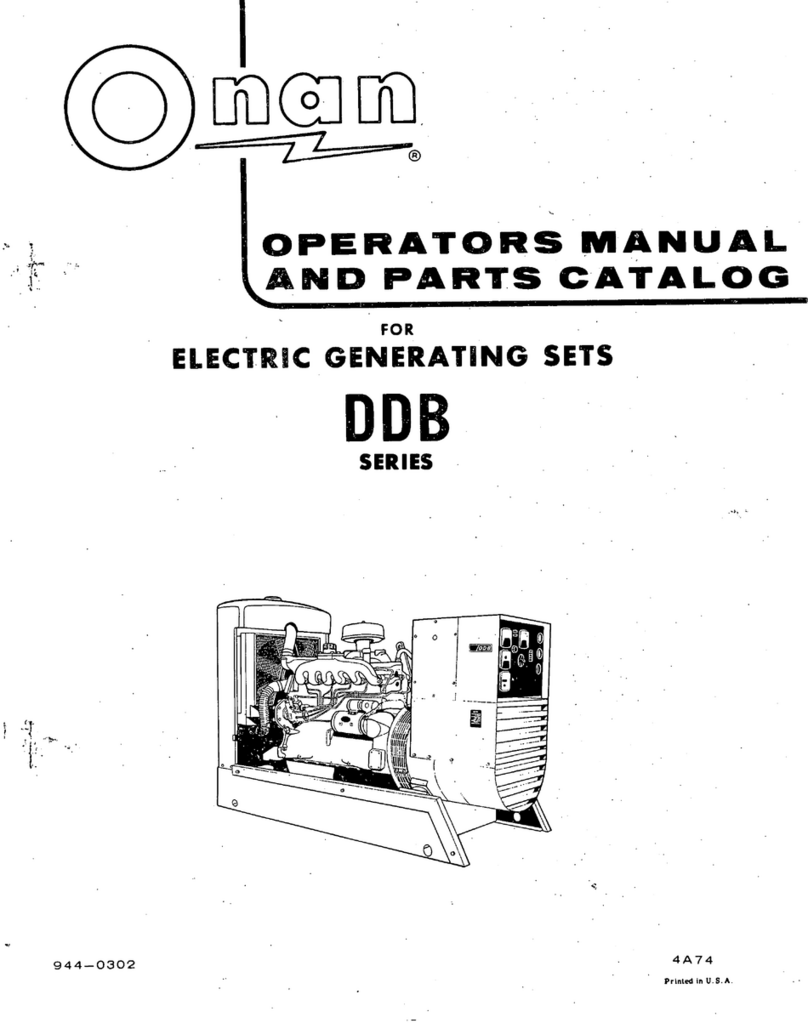
Onan
Onan 50.0DDB-15R Series Operator's manual and parts catalog
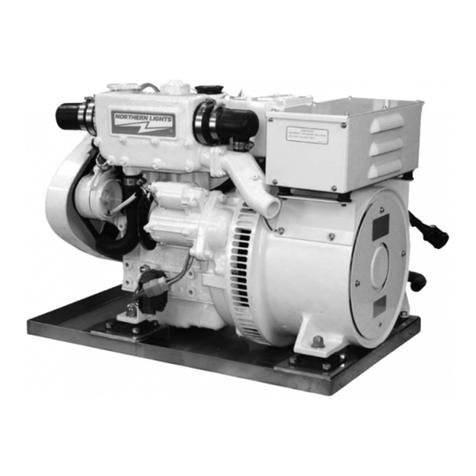
Northern Lights
Northern Lights M673L2 Operator's manual
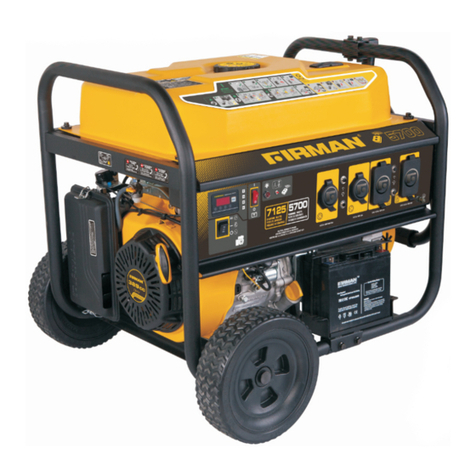
Firman
Firman P05702 owner's manual

Jefferson
Jefferson OLYMPUS JEFGENPET30EL user manual
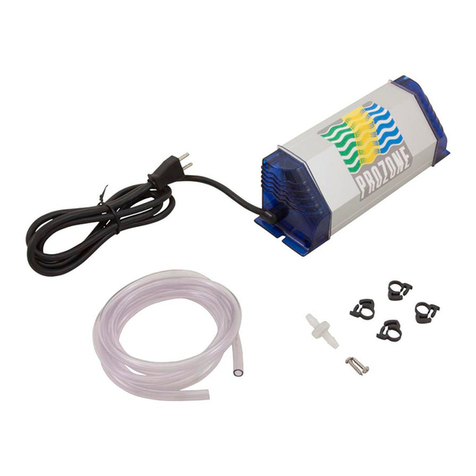
Prozone
Prozone PZ1 Installation guide and operation manual

Clarke
Clarke WLD180 Operation & maintenance instructions
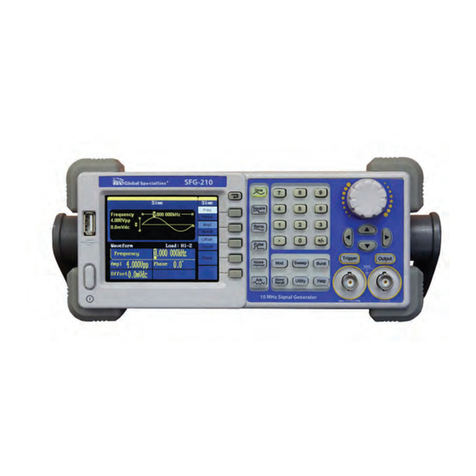
Global Test Supply
Global Test Supply SFG-205 user manual
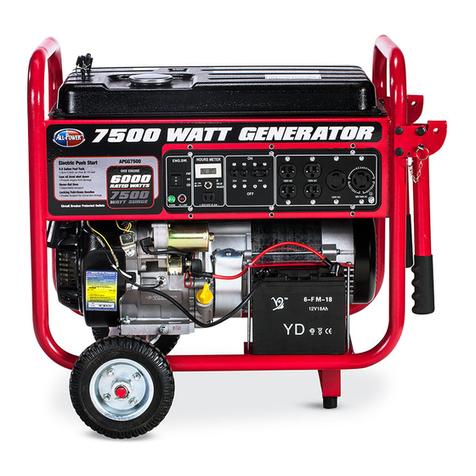
ALLPOWER
ALLPOWER APGG7500 owner's manual

XPOtool
XPOtool 62739 Operation manual

Chicago Electric
Chicago Electric 95126 Assembly and operating instructions

COMPANION
COMPANION CAMPANION 919.32721 owner's manual
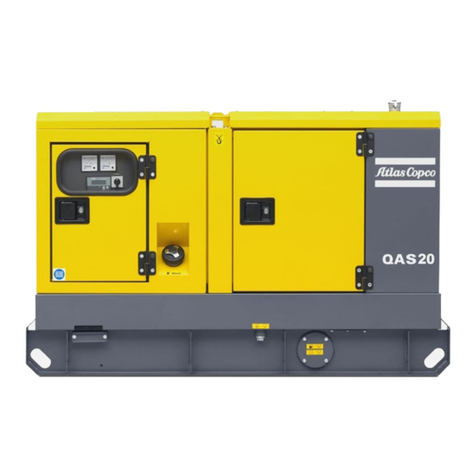
Atlas Copco
Atlas Copco QAS 20 instruction manual
